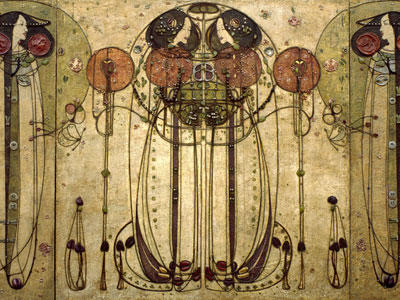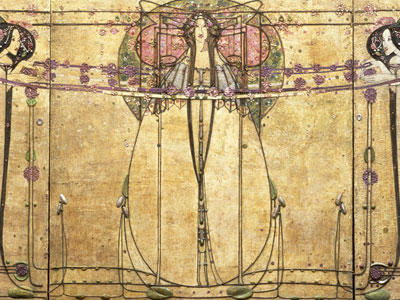Ingram Street Tearooms
Background
The Ingram Street Tea Rooms were some of the first dining establishments created by Catherine Cranston at the end of the nineteenth century in Glasgow. Unlike previous eateries, clubs, or public houses that catered exclusively to certain groups of men, tea rooms catered to a wider clientele and were the first dining establishments to allow unaccompanied women. Scottish architect Charles Rennie Mackintosh was first involved with the tea rooms in 1895 when Cranston commissioned the design of several murals for the Ingram Street Tea Rooms. From 1900 to 1912, Mackintosh designed several tea rooms in Glasgow for Cranston, including the complete redesign of the Ingram Street Tea Rooms from 1900, were he became the sole designer, working together with his wife, Margaret MacDonald. The color scheme, layout, decorative and furniture design varied according to each room’s unique theme. Created in 1886, Miss Cranston’s Ingram Street Tea Rooms continued in the food catering tradition for over sixty years. In 1950, Glasgow Corporation acquired the Ingram Street building, and the tea rooms were used for storage. Before the building was demolished in 1971, the rooms were thoroughly documented and catalogued. The interiors were dismantled and moved to a storage space until they were transferred to Glasgow Museums in 1978, where they remained in storage for the next fifteen years.
How We Helped
In 1995, WMF, with support from the Samuel H. Kress Foundation, assisted the Burrell Collection in conserving two gesso friezes from the Ladies’ Luncheon Room in the Ingram Street Tea Rooms. The work represented the first phase of a long-term project to restore all eight Mackintosh rooms from Ingram Street for display in a new National Gallery of Scottish Art in Glasgow. The Wassail, by Mackintosh, and The May Queen, by Margaret MacDonald, created in 1900, are two large-scale wall friezes that hung above the tearoom windows as prominent features in the room. The conserved friezes were part of an exhibition of Mackintosh’s work mounted by Glasgow Museums, which toured the United States in 1997.
Why It Matters
Miss Cranston’s tea rooms are among Mackintosh’s most celebrated works, yet none remain intact in their original context. Before The Wassail and The May Queen gesso friezes were placed in the Ladies’ Luncheon Room in Ingram Street, they were shown that year as the centerpiece of the Mackintosh exhibit at the Eighth Secessionist Exhibition in Vienna. Now part of the Charles Rennie Mackintosh and the Glasgow Style gallery in the Kelvingrove Art Gallery and Museum, the restoration of the Ingram Street Tea Rooms interiors for public display allows visitors to experience the original ambience and aesthetic sense from one of Miss Cranston’s legendary tea rooms.


